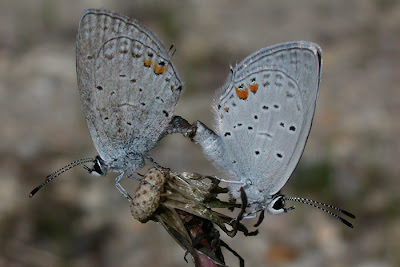Belleplain is about to burst! No, there's no need to take cover, Belleplain State Forest is about to burst forth with spring vigor, just in time for our spring Belleplain programs which step up the pace over the next week or two. Our Saturday bird walks started March 31st, Thursday morning walks begin April 5th (yes, tomorrow!) and our 'Hidden Corners of Belleplain' Tuesday walks begin April 17th. In addition, we have a new Sunday walk, starting April 15th, which will look at all aspects of Belleplain wildlife, whether it be birds, botany, bugs or beasts. Indeed, it was in preparation for this last walk that I had a quick run around the area this morning after our Cape May Point State Park walk and, with temperatures snuggling nicely into the low 70s, there was already plenty to see. The good thing about April is that the native flowers really start to come out; yes, a few just squeak in at the end of March (especially in this crazy spring we are having!) but generally, pretty much everything you see in flower in March will be an alien introduction.
So, give our Belleplain walks a go this year and come and see what Cape May County has to offer at the 'top end'. Here's a few pictures from today to whet your appetite...
Singing from a Pitch Pine near you! Yellow-throated Warblers are one of our earliest spring migrants and good numbers were already singing in Belleplain before the end of March. This species is very much tied to pine trees for breeding and foraging [photo by Mike Crewe].
Mind your step! Many of our native spring wildflowers are small and easily missed without a careful eye. Common Blue Violet (Viola sororia) is flowering in many places right now but needs to be carefully searched for [photo by Mike Crewe].
Much rarer than the violet, the tiny yellow flowers of Ipecac Spurge (Euphorbia ipecacuanhae) are just emerging now. Look for them in bare, sandy patches - but you might need to get down on your hands and knees! [Photo by Mike Crewe]
April is the month when dragonfly fans come out of hibernation and Tony Leukering alerted me to these two species (above and below) which are now on the wing. Though the one above is rather uninspiring at first glance, it does have some nice, delicate orange markings and smart pale bluish patches at the bases of the wings - and it has the wonderful English name of Uhler's Sundragon [photo by Mike Crewe].
The other dragonfly out at Belleplain at the moment is more imposing; the wonderful black and pale yellow Twin-spotted Spiketail. Spiketails generally like running water and prefer streams with sandy bottoms, a habitat that is not common in Cape May, though this species is common in other parts of New Jersey. Perhaps not surprisingly this year, Tony Leukering's discovery of this species on April 3rd probably sets a new earliest date for the species in New Jersey. [Photo by Mike Crewe]
Recent Reports
As well as
Yellow-throated and
Pine Warblers in Belleplain today, I was pleased to come across a superb male
Black-and-white Warbler, singing whilst investigating a tree trunk just two feet off the ground. Karen Johnson reported another from near Tarkiln Pond today and she also found a
White-eyed Vireo on Tom Field Road (near Sunset Bridge). Michael O'Brien was busy logging birds in his back yard this morning and noted
Solitary Sandpiper, White-eyed Vireo, Blue-gray Gnatcatcher (also at Belleplain today) and
Dickcissel there. Just across the bay, Tony Leukering reported news of a remarkably early
Black Tern which flew north off Rehoboth Beach, Delaware today. At the point this morning, the
Northern Gannet movement was dramatic for another day, while our walk group also added two
White-winged Scoters, an impressive showing of fly-over, full breeding-plumaged
Common Loons, incoming
Glossy Ibises and
Double-crested Cormorants, a
Merlin worrying the
Purple Martins for the second day running and an amazing
Virginia Rail at less than 10 feet! Also of interest, Peter Bosak reported a
Sandhill Crane flying west over Beaver Dam, South Dennis on 3rd, while Jim Cremer had a single Sandhill flying over the South Cape May Meadows this morning (4th). Sandhill Cranes remain pretty uncommon here and details are bound to be asked for. Of course a Sandhill Crane is easy - an all gray bird with a long, outstretched neck and long legs, but Great Blue Herons sometimes fly with their necks out too! How to be sure you have got it right? Well if you can take a photo, you could save yourself a lot of description writing (see below)!!
Warren Cairo sent me this picture of a group of loafing gulls at South Cape May Beach which includes three Lesser Black-backed Gulls - I'll let you find them!
Both Jim Cremer and Peter Bosak were able to get 'record shots' of their Sandhill Crane sightings, perfect for helping with any claim of an unusual bird. This is Peter Bosak's bird at Beaver Dam on 3rd.
 [One of very many Barn Swallows over
[One of very many Barn Swallows over [Well over 30 Cliff Swallows could be found between Bunker Pond and the South Cape May Meadows last night-- a notable spring count. Days with northwest winds always tend to produce at least a few of these in April. Photo by Tom Reed.]
[Well over 30 Cliff Swallows could be found between Bunker Pond and the South Cape May Meadows last night-- a notable spring count. Days with northwest winds always tend to produce at least a few of these in April. Photo by Tom Reed.]
































